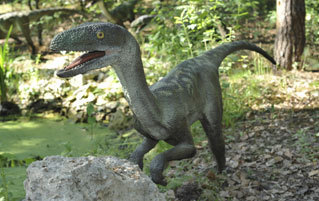The 6 Most Horrifying Robotic Animals That Actually Exist

Human beings have been building robots for a few millennia. But no matter how useful our automata, or how sleek and efficient our killing machines grow, we know we'll always be second best. Nature has been building high-end meat-bots for millions of years, after all. Well, we're tired of coming in second. They say that imitation is the sincerest form of flattery, so Mother Nature, consider these bizarre and terrifying abominations a compliment ...
The Sprinting Velociraptor Robot Is Faster Than Any Man Alive

As ED-209 and Claptrap have taught us, the one thing that can stop the bloody robot uprising is a good solid set of stairs. Agility has always been a problem for the machines. We may not be able to hide, but at least we can still run. Not so, anymore! Scientists in South Korea have designed a robot that can attain a blistering footspeed of over 28 mph. And because you've been very naughty this year, they modeled the son of a bitch after a velociraptor.

"The inspiration is clear," said Dr. Muldoon.
They haven't yet wrapped it in scales (or feathers, depending on how hilarious and/or biologically accurate they want to be), but they've definitely got the raptorial framework down. The legs are made from race-car-caliber carbon fiber, and have artificial Achilles' tendons to dissipate ground reaction forces. The large tail swings around to act as a counterbalance, allowing the raptor to keep on truckin' even when a scientist tries to knock it off course by placing obstacles (soon to be your children) in its path.

Impressively, it's already bested Usain Bolt's top speed, which has been clocked at 27.44 miles per hour. We're not sure who's funding the project to build a robotic velociraptor specifically capable of running down the fastest man on earth, but we're going to assume he's got at least a master's degree, if not a doctorate, in doom.
The Crabster CR200 Is a Giant Walking Crab Tank

Video games and sci-fi movies are full of all sorts of fantastic machines and vehicles that look badass on the screen but would be completely impractical in real life. The reason you're not driving to work every day in a giant lumbering crab tank is because at some point humanity realized that wheels were way easier, and we're apparently a species that settles. Or at least, we were. Meet the Crabster:

"Also great for enchanted beast-nobles who need creepy transportation to town."
Using 6-legged locomotion to safely traverse the seafloor at breakneck speeds of up to 1 mile per hour, the Crabster weighs in at 1,400 pounds and is controlled remotely through a 500-meter tether. The cable serves to relay information back to headquarters, and also to ensure that Cthulhu doesn't partake of a little twelve-tentacle discount.
The craft responded well to initial underwater testing, and now has its first official job on an archaeological recovery mission in the Yellow Sea, where previous craft have proven ... unworthy.
Designed by Korean scientists, the Crabster addresses some of the main challenges faced by traditional marine exploration, like the ineffectiveness of propeller-driven craft when facing strong tides, or how divers are at the mercy of rough waters. You know what doesn't have trouble with tides, rough waters, or Aquaman's pesky meddling? Giant cyberpunk crabs.

You know what else crabs have no capacity for? Fear.
The Flying Bat Drone Combines All Your Fears of Robots and Bats

Unwilling to wait for reality to catch up with fiction, engineers at the University of Michigan have already started working on Batman's equipment.

"Why is U of M submitting a grant request for a hollowed-out cave?"
"Who knows? Just approve it."
The team behind the bat-drone call themselves the Center for Objective Microelectronics and Biomimetic Advanced Technology, or COM-BAT for short. Welp, they've got a pun-based acronym and a freaky robot. They're one tragic scarring chemical explosion away from eligibility for the League of Evil.

"It's only a little acid, Steve. Take one for the team."
The six-inch drone, which the Army has provided $10 million to develop, will come with an array of sensors that allow the "bat" to capture sights, sounds, and smells, as well as analyze the air for poisons and radiation. More ambitious is the development of a special lithium battery (we assume they air-quote the "bat" part during presentations) that can recharge itself by "scavenging" solar, wind, and kinetic energy. Much like a real bat, the artificial version will be able to direct itself using a type of echolocation, making it equally adept at night or in situations with hindered visibility.
Finally, you can stop worrying over that silly phobia of real bats, and start worrying about the energy-draining robo-bats of the future.
The Hopping Bionic Kangaroo Will Never Stop

Festo Labs, headquartered in Germany, has built a robotic kangaroo. Because if you're going to give robotic life to anything from Australia, that's pretty much the sole safe option on the table.

The worst they can do is disembowel you while punching you in the face and/or drowning you.
It seems that kangaroos, rabbits, and Wile E. Coyote that time he put springs on his feet all have it right -- hopping beats walking, crawling, slithering, and bumming rides from your roommate with a car as the single most efficient method of locomotion. And you know how Germans feel about efficiency. Kangaroos in particular have stoked the scientists' Teutonic lust, because large tendons in their legs harness massive amounts of elastic energy, enabling them to conserve energy from jump to jump. This allows the kangaroo to travel great distances with a relatively small amount of effort and caloric expenditure. Who's stupid for hopping to school on their Moon Shoes now, mom?

Though we will concede that trying to stuff our little brother into a fanny pack may have been ill-advised.
Festo used a combination of pneumatic and electrical components to power the kangaroo, creating a robot capable of fluid movement, though it can't quite jump high enough to make it out of the uncanny valley.

But high enough to jump into our hearts.
The kangaroo is also light enough to travel a hell of a long ways with very little energy, so if we could somehow integrate this hopping technology into automobile design, we'd have ultra-efficient vehicles and probably some really dangerous freeways.
The Butterfly Drone Will, Uh ... Flutter ... Menacingly ... At You?

Israel has one of the most elite militaries in the world. Surely, their robots must meet or exceed all federally-mandated terror standards, right? Well, here's their newest bit of tech:

"BOW BEFORE ME, PUNY MORTALS!"
Built by Israel Aerospace Industries (IAI), the Butterfly Drone comes with a camera and memory card that, at .15 grams, weighs about as much as the average wish. They say the drone is smaller than some actual butterflies, though it appears to be the size of that guy's whole face, which begs the question: what kind of terrifying butterflies are flitting about Israel?
The drone's relatively, uh, diminutive size allows for indoor deployment, whether it be in enemy bases, buildings, tunnels, or terrorist caves. You know how those terrorist caves are chock-full of butterflies. Furthermore, it's so portable that it can be stored in a pocket until it's ready to be deployed. Or perhaps it could just alight softly on the tip of a soldier's nose before battle. Whichever seems most appropriate.

All troops are to be issued combat daises for drone deployment.
One small problem: during a test flight, the butterfly drone managed to attract a flock of birds, which are unfortunately now the chief natural predator of Israeli surveillance.
The Flying Jellyfish That Defies Explanation and Budget Alike

Let us set the scene. You're a typical scientist -- your huge science-brain has left you feeling alienated from humanity, you want to seek revenge, and you figure the best way to do that is by building flying robots. Where do you take your inspiration? From butterflies? Too weenie. Bats? That's a little more disturbing, but it's been done. How about ... jellyfish?
New York mathematicians Leif Ristroph and Stephen Childress decided that, yes, a flying jellyfish was disconcerting enough to satisfy their overall discontent with humanity, and so they promptly built one:

Behold! The technological marvel that literally no one asked for!
Actually, what Ristroph and Childress wanted to do was create the simplest possible flying machine, which meant doing away with things like sensors, batteries, propellers, and other extraneous parts. The motor that powers the flaps is the size of a pea, and that's about all there is to it. The robot is otherwise technologically bare. Such a simple design means low costs, and Ristroph suggests that a commercial version of the robot could retail for as little as 50 cents. Spend 50 bucks to absolutely flood a room with wildly flailing flying jellyfish robots? Sounds like a bargain to us.

Because this is apparently simpler than a paper airplane.
We'd explain how the thing works in more depth, but the creators admit that they don't really know themselves. Science was so busy thinking about whether or not it could, it not only didn't ask if it should, it even stopped asking how it was doing this shit in the first place.
For more ways we're committing hubris against nature, check out 6 Man-Made Natural Disasters Just Waiting to Happen and 6 Natural Disasters That Were Caused by Human Stupidity.
Click the Facebook 'share' button below, and let the good news about science flow o'er the land.
